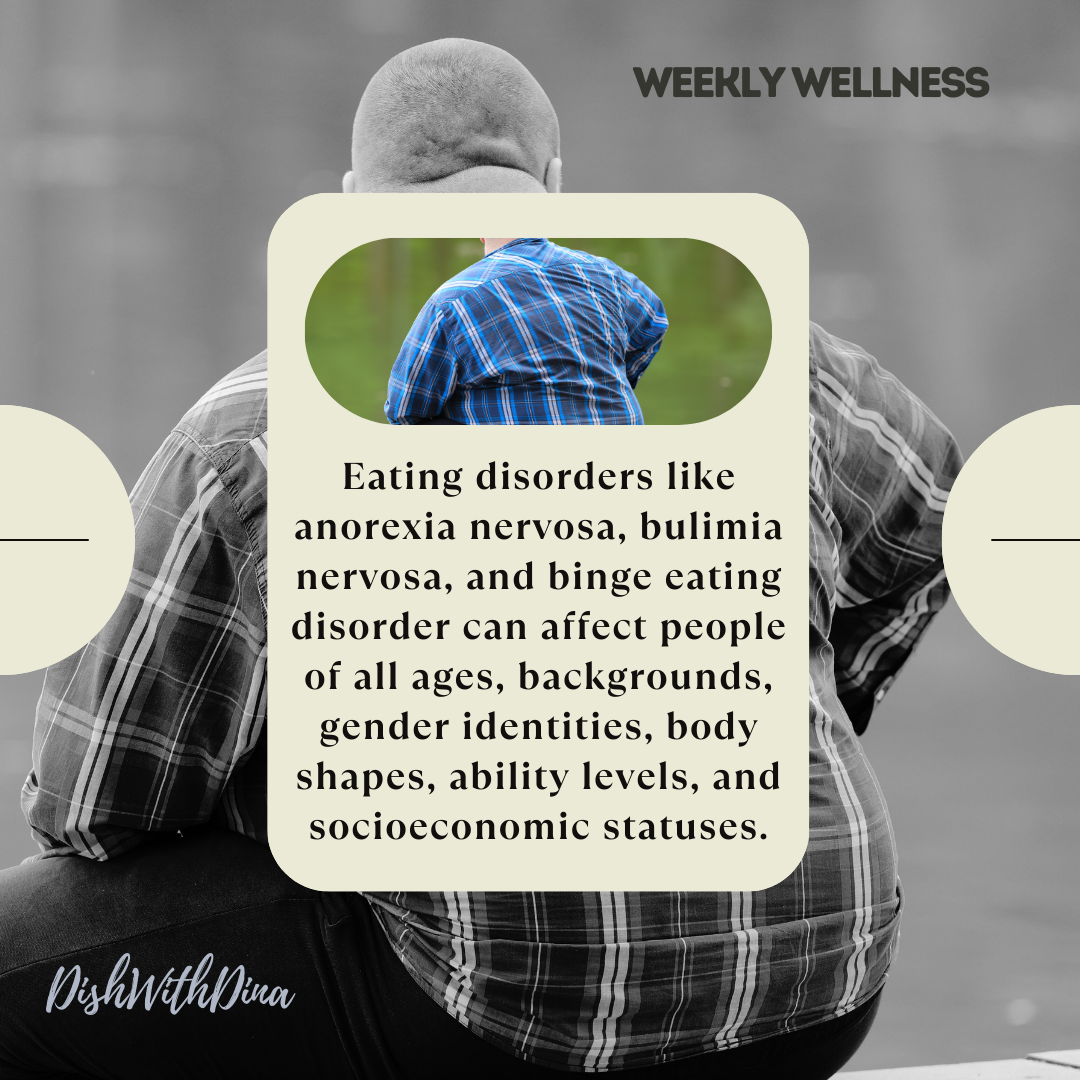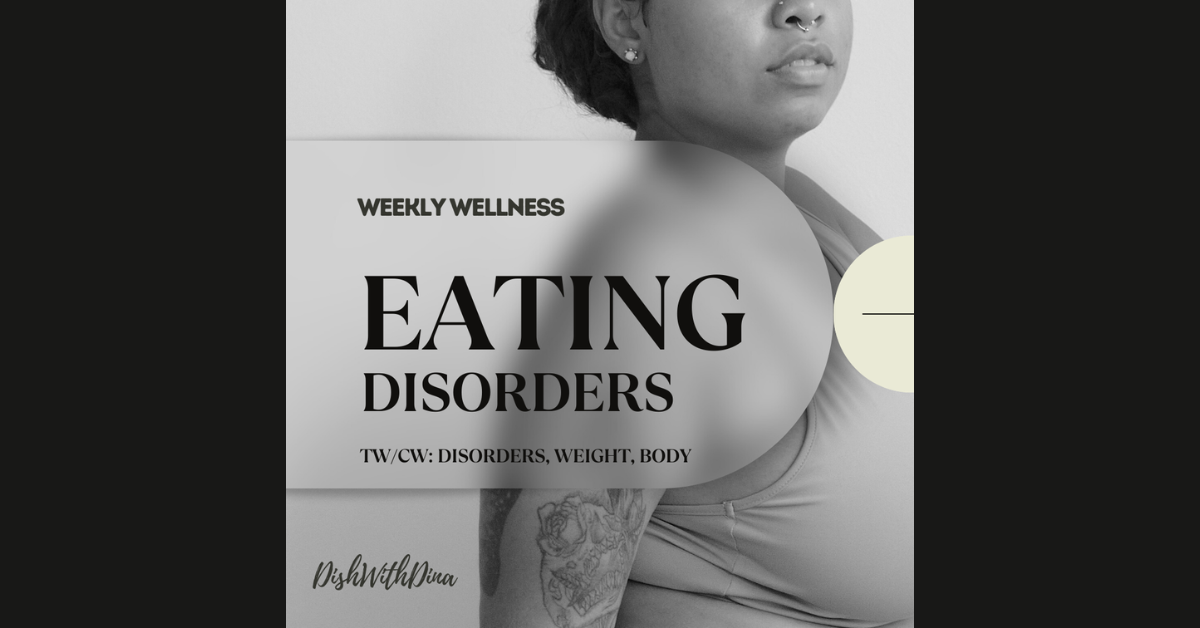Explore the delicate topics of eating disorders and disordered eating with compassion and understanding. Learn about available resources, self-awareness, and the importance of seeking professional help when needed.
While we’ll be examining this topic as respectfully as possible during National Eating Disorder Awareness Week, this can be a sensitive subject to some, so please consider this a trigger/content warning if you prefer to skip what we’re sharing.
What or who do you picture when you think of eating disorders? Contrary to what is represented in the media, eating disorders are not always reflected in someone’s shape, size, or age. Those who suffer do so invisibly among us. Eating disorders can affect individuals of all ages, including very young children. Research has shown that these complex illnesses don’t discriminate based on age, emphasizing the importance of awareness and early intervention [1]. Weight is not always an indicator of an eating disorder. Someone may appear “healthy” (however you might define that) but still struggle with control over food or take restrictive approaches when eating. In doing so, eating disorders can have severe physical consequences, affecting the heart, bones, and other vital organs.

Behind the scenes
Eating disorders are serious mental health conditions, not a lifestyle choice. So much so that eating disorders are diagnosed and classified according to criteria published by the American Psychiatric Association (APA) in the Diagnostic and Statistical Manual (DSM) which recognizes the following:
- Anorexia nervosa (AN)—a condition of extreme restriction of calories—and bulimia nervosa (BN)—which consists of episodes where large amounts of food are consumed in a short time, follwed by compensatory behaviors such as purging through vomiting, excessive exercise, or misuse of laxatives or diuretics—are linked to hypothalamic amenorrhea in some females. Those with AN or BN are more likely to miscarry, have preterm delivery, and deliver low birthweight infants. Thankfully, ovulation and menstruation resume with normal eating and weight stabilization.
- Binge-eating disorder (BED) which includes recurrent episodes of uncontrollable overeating, often accompanied by feelings of guilt or shame. Individuals with BED may consume large amounts of food rapidly, feel a lack of control during the binge, and experience distress afterward, but, unlike other eating disorders, individuals with BED do not engage in compensatory behaviors like purging or excessive exercise.
- Avoidant/restrictive food intake disorder (ARFID), a behavior usually associated with children and sometimes called “picky” or selective eating. ARFID can result in nutritional deficiencies and can stem from fear or anxiety about certain foods or sensory sensitivities, especially in those with neurodivergent disorders.
- RED-S, or Relative Energy Deficiency in Sport (formerly known as female athlete triad) is a condition where athletes don’t consume enough calories to meet their energy needs. This can lead to a wide range of physiological and psychological consequences, including hormonal imbalances, impaired bone health, decreased performance, and psychological disturbances [3]. In my work with college athletes, I’ve found this is an issue when students are so focused on competition and performance that they forego nourishing their bodies and replenishing their protein and energy stores.
Recognizing warning signs
Warning signs may include extreme weight changes, food rituals, excessive exercise, or secretive behavior around meals. As a dietitian, I’m somewhat limited in recognizing deep-seated symptoms of disordered eating, and never want to take a chance in triggering someone with language that may exacerbate their condition [2]. This is why I ask every one of my patients if they also work with other healthcare providers, especially therapists or social workers since mental health support is so crucial and early intervention can improve recovery outcomes. Depending on the severity of the disorder, treatment involves a multidisciplinary approach, including therapy, nutrition counseling, and medical care.
Because body image issues and low self-esteem are often linked to eating disorders, media portrayal of unrealistic body standards can exacerbate eating disorders. The internet wasn’t even invented when I was a child, but I could remember flipping through Seventeen magazine in middle school which, at the time, promoted the thin ideals that drove me to restrict my diet to look like the girls featured on the cover.

Language and influences
Research shows that children as young as five become aware of different body types and labels like “fat” and “thin”, especially when growing up with a parent who has been a chronic dieter [4]. Something as simple as hearing “you’re at the top of the growth curve” can begin to shape how a child sees themselves and how they eat. Too often, I find that my patients will get caught up in comparing themselves to unrealistic beauty standards on social media, or forget that celebrities and “influencers” lead a much different lifestyle than the “regular” person, where they may receive financial support or collaborate with brand deals that allow them to spend an extraordinary amount of time on their outward appearances. I would also advise to be cautious about nutrition advice on social platforms. Recent and regular trends on TikTok promote disordered eating habits. Your well-being is more important than viral challenges, and misinformation can be harmful. In my opinion, working with a registered dietitian is the only way to obtain reliable and individualized food and nutrition guidance.
To understand more deeply the power of our words around children, check out this interview with Registered Dietitian Amelia Sherry:
The road to recovery
Recovery is possible with proper support, therapy, and a holistic approach to health. Support from family and friends also plays a pivotal role in recovery. Online communities and support groups can provide comfort and understanding for those affected. Self-care, self-compassion, and a balanced approach to food and exercise are key aspects of recovery. Awareness and education are vital in reducing stigma and promoting understanding about eating disorders. Avoiding judgmental or triggering language is important when discussing eating disorders. Relapse is common but doesn’t signify failure; it’s part of the recovery process.
Some guidance if you or someone you know might be struggling with an eating disorder:
- Warning Signs: Learn to identify warning signshttps://www.womenshealth.gov/nedaw of eating disorders, such as changes in eating habits, excessive exercise, and significant weight fluctuations.
- Professional Help: Seek professional help from healthcare providers, therapists, and dietitians with expertise in eating disorders.
- Online Resources: Access reputable online resources and helplines for individuals seeking information and support.
- Recovery Journey: Share stories of individuals in recovery to inspire hope and reduce stigma.
- Educational Initiatives: Support educational initiatives that focus on preventing eating disorders through awareness and early education.
References
- Gagne, D. A., Von Holle, A., Brownley, K. A., Runfola, C. D., Hofmeier, S., Branch, K. E., & Bulik, C. M. (2012). Eating disorder symptoms and weight and shape concerns in a large web-based convenience sample of women ages 50 and above: results of the Gender and Body Image (GABI) study. The International Journal of Eating Disorders, 45(7), 832–844. https://doi.org/10.1002/eat.2203
- Three Power Tools in Eating-Disorder Counseling. (2025). Todaysdietitian.com. http://www.todaysdietitian.com/newarchives/062810p14.shtml
- Cabre, H., Moore, S., Smith-Ryan, A., & Hackney, A. (2022). Relative Energy Deficiency in Sport (RED-S): Scientific, Clinical, And Practical Implications for the Female Athlete. Deutsche Zeitschrift Für Sportmedizin/German Journal of Sports Medicine, 73(7), 225–234. https://doi.org/10.5960/dzsm.2022.546
- ABRAMOVITZ, B. A., & BIRCH, L. L. (2000). Five-Year-Old Girls’ Ideas About Dieting are Predicted by Their Mothers’ Dieting. Journal of the American Dietetic Association, 100(10), 1157–1163. https://doi.org/10.1016/s0002-8223(00)00339-4



0 Comments